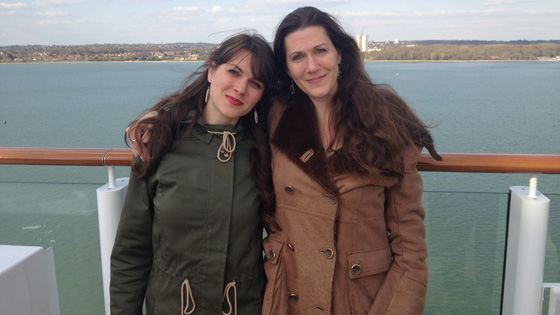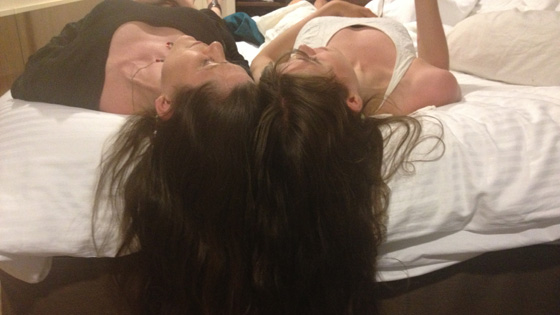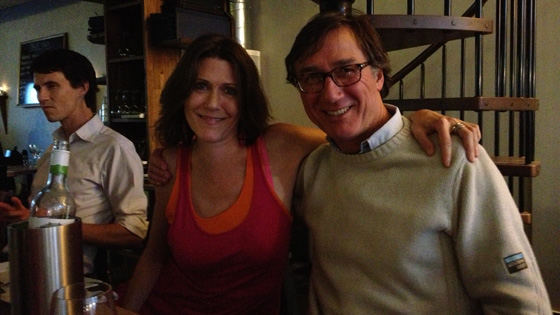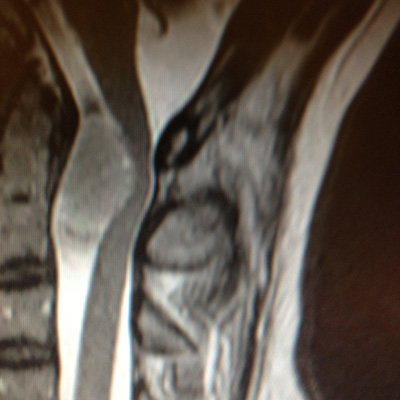It All Started at The Drake Hotel is a five-part series chronicling one woman's cancer experience. Elizabeth gives us an uncut, uncensored version of her breast cancer story – and how food, family, friends and a little bit of Prosecco can go a long way.
Once I recovered from surgery, I knew I would have to start chemotherapy. I only had one small problem: I had a date with my daughter and a transatlantic cruise – the trip of a lifetime – one month post-op, followed by trips to California and Sweden.
Did you miss part one? Click here to read

Elizabeth and her daughter, Emily, casting off on the Norwegian Breakaway (Photo: Harold Van Johnson)
I knew that cancelling the cruise, and other events I was looking forward to, would be surrendering to the disease. This was contrary to my nature.
When we met a few weeks after my surgery, I informed my medical oncologist, Eitan Amir, that I was not going to cancel any of my plans.
The Norwegian Breakaway would set sail on April 30 from Southampton, England and dock in New York on May 7, where my daughter and I would visit my parents. The following day, I would fly to Irvine, California, to give two workshops to physicians and administrators, then visit my brother and sister-in-law in San Diego, before returning home. A week later, I was to fly to Gothenburg, Sweden, to present a paper at the Health Promoting Hospitals Network conference.
Eitan was willing to accommodate my travel schedule.
"You'll have your first treatment on May 15, between California and Sweden," Eitan said.
"Okay!" I knew I was taking a risk, leaving the country without knowing how I would react to the chemotherapy, but I didn't know if I would ever have another opportunity to present to this group.
Going public with cancer
Ironically, two years before the diagnosis, my daughter Emily had suggested we grow our hair and donate it to one of the organizations that makes wigs for women who have lost their hair to cancer.
After my diagnosis, we decided to raise funds for research at Princess Margaret Cancer Centre. Our hair, by that time, reached our respective waistlines.
Until that point, Emily and I had kept my diagnosis private, among family and close friends. During the cruise, we both made the difficult decision to go public.
As we read the thoughtful, encouraging messages from family and friends, we knew that we had made the right decision.

Elizabeth and her daughter, Emily, come out of the “C” closet for a good cause (Photo: Harold Van Johnson)
Travelling the high seas with Emily and our friends was a magical experience. We bought passes to the Thermal Suite, a steamy, luxurious spa at the front of the 15th deck, with floor to ceiling glass on three sides.
We dined and danced every night with our friends. We soaked
en masse in outdoor Jacuzzis, gazing at the Atlantic Ocean all around us.
Of course, it would have been even better if Solomon had agreed to join us. He took a pass because he was underage and hanging out with strangers just because they were his own age did not appeal to him in the least.
On the last day, Emily and I daydreamed about finding a place to hide before we docked, so we could stay on the ship forever.
New York and California
My dad, who has been calling me every day since my diagnosis, picked us up at the docks on the lower East Side of Manhattan, and we spent the day in the city.
The following day, I flew to California, ran the workshops and then visited my younger brother, Scott Abraham, and my sister-in-law, Stacy Brenner. They were wonderful hosts, and we had fun together in sunny SoCal: the beach, downtown, and sunset cocktails at a swanky hotel.
My family is super cool. We are all a bit crazy, in a good way, and we always have fun together. When my dad, the iconic patriarch, gets everyone together, it's like a circus, in a good way. Everyone in my family rallied around me when I was diagnosed. I'm very fortunate.
The day after I returned from California, celebrity stylist and my dear friend, Steve Roy, cut Emily's and my hair at Solo Bace in Yorkville. We raised over $2,000.
Sporting a new bob, I met with Eitan the day before my first chemotherapy session. He handed me a copy of a report from my full spine MRI. There was a 2.4 cm tumour compressing my spinal cord at C1.
What the….?
"They say it's critical," he said, "but I don't think it will be necessary to interrupt chemotherapy. In any case, I'll refer you to a neurosurgeon for a consult." It was booked for the day after I returned from Sweden.
A tumour on my spinal cord, just beneath my skull? Seriously?
The following day, after my son, Solomon, left for school, Emily and I packed for chemotherapy as though we were going to a picnic. Sliced mango and papaya, dark chocolate, cards, music, an iPad to watch movies and, of course, Prosecco (Italian sparkling wine from the Veneto region) – anything we could think of to make the road a little smoother.
Our nurse couldn't have been nicer. She had to administer four tubes of medicine manually, which meant that once she inserted the needle and snaked it up my vein, she literally pushed the fluid into my vein, bit by bit, staring at my arm to make sure the medication didn't leak into the surrounding tissue. This took about an hour and a half. The last medication was administered by pump.
Emily and I were so busy talking and laughing with the nurse that we never had time to watch a movie or play cards. Except for the insertion, it was all quite pleasant.
The next day, I still felt fine. No nausea, no change in appetite.
Next stop – Sweden

Elizabeth and Dr. Antonio Chiarenza at a conference in Gothenburg, Sweden.
The conference in Gothenburg, Sweden was transformative. The theme of the conference was Body and Mind, and one of the streams was psychoneuroimmunology: the impact of mental state on immune response. During the opening plenary session, I felt as though the universe meant for me to be there and hear about this research.
My mental state can influence my immune system. Brilliant! I can get through this. I will get through this.
Gothenburg was also about seeing friends I work with, from Toronto and internationally, who comforted me with stories of survival, hugs and, from one Norwegian colleague, healing teas. At the gala dinner, with friends Antonio Chiarenza, Susan Himel, Branka Agic and others, I danced for hours with health promoters and CEO's of regional health authorities from Europe. At 2 a.m., I had a nightcap on the roof of the tallest hotel in the city.
I didn't experience any nausea following the chemotherapy, but I was tired and had to lie down two or three times a day.
A medical mystery
When I returned from Sweden, I met with neurosurgeon Michael Fehlings at Toronto Western Hospital. He specializes in spinal cord tumours. I had taken Emily with me to be my scribe and later regretted the decision. The news frightened both of us to the core.
Before meeting with Michael, a neurosurgery fellow showed me the image of my cervical spine. The tumour took up most of the space of my spinal canal. My spinal cord was smashed against one side.
I told the fellow, "I'm surprised I have no symptoms." She responded, "With this kind of compression, I'm surprised you're not in a wheelchair."

Elizabeth’s spinal cord was smashed against one side – she would require surgery to remove the tumour. (PMH MRI)
I turned to Emily and said, "I'm a medical mystery!" I could tell that she was reeling from the image on the monitor, as was I.
After an examination, Michael asked about my treatment plan, which at that time was one year. Michael didn't want to wait that long to remove the tumour, which would eventually stop my heart from beating, and my ability to breathe.
He proposed the window between chemotherapy and my next surgery to remove all of the lymph nodes under my left arm.
"But if you have any symptoms, we'll have to interrupt chemotherapy."
Emily and I looked at each other, still in shock.
"The first sign of numbness or tingling in your hands or feet, call me," he said.
Emily and I left the hospital, stunned.
An appointment like that should be followed by brunch. What better place than The Drake Hotel, where it all began?
Emily and I ordered mimosas.
As we waited for our meal, Emily asked, "Mom,
why are tumours growing in your body?"
An excellent question. It made me think of something I'd read years ago. "If you place stress on an organism, disease results." I wondered how much stress one can endure before the immune system is compromised.
I called my older brother, Carl Abraham, an infectious disease specialist, as Emily drove home. I put him on speaker phone to share the news. He was at first incredulous, then compassionate and supportive.
We all agreed:
no one needs to know about this. Not my son, Solomon, not my parents, no one. It's just too much bad news.
Two weeks after my first treatment, when my hair started falling like rain from my head, we finally had proof that the chemotherapy was working. Aside from acute fatigue, I hadn't experienced any side effects yet.
A week later, my left hand went numb. I immediately assumed it was psychosomatic. But the numbness didn't go away.
Two days later, there was something wrong with my left foot. It was numb, too.
Stay tuned for It All Started at The Drake Hotel: part three. Elizabeth deals with the tumour on her spinal cord, and prepares for a life-threatening surgery.
You can read more about Elizabeth's experience at The Mental Breast.
*Special thanks to Elizabeth for sharing her story with such wit, elegance and candour.
